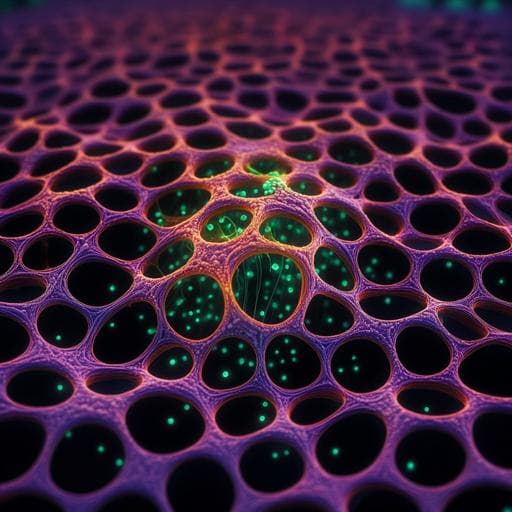
Engineering and Technology
Ultrastable Co-NC membrane for sterilization of *Escherichia coli* in flowing water
C. Li, J. Li, et al.
Discover the revolutionary Co-NC membrane designed for water sterilization. This advanced technology, developed by Chao Li and colleagues, achieves an astonishing 99.9999% efficacy against *E. coli*. With remarkable stability even after 40 use cycles, it promises to transform water purification processes, ensuring clean water is within reach.
~3 min • Beginner • English
Introduction
The study addresses the pressing need for efficient, safe water disinfection methods that overcome limitations of conventional approaches (UV, chlorination, ozone) such as resistant biohazards and disinfection by-products. Advanced oxidation processes (AOPs), particularly persulfate-based systems using peroxymonosulfate (PMS), offer wide pH adaptability and efficient inactivation via multiple reactive pathways. Cobalt-based PMS activation is highly effective but suffers from Co-ion leaching and poor catalyst recovery in homogeneous or slurry heterogeneous systems, limiting practical deployment. The authors propose a robust, scalable membrane catalyst composed of cobalt nanoparticles encapsulated in nitrogen-doped carbon nanotubes (Co-NC) integrated into a continuous flow reactor to minimize cobalt leaching, enhance recoverability, and deliver high, durable antibacterial performance in flowing water, including real water matrices. The research tests the hypothesis that Co-NC membranes will stably activate PMS to generate potent oxidizing species—dominated by high-valence Co=O—achieving rapid, long-term bacterial inactivation with minimal Co leaching and strong tolerance to environmental constituents.
Literature Review
Background highlights include: (1) AOPs surpass traditional disinfection in efficacy and reduced DBPs; persulfate-based AOPs, especially PMS, are more stable and easier to store than peroxide systems and can generate radicals (SO4·−, ·OH) and nonradical species over a broad pH range. (2) Cobalt-based catalysts are widely used for PMS activation, but homogeneous Co²⁺ systems cause leaching hazards and heterogeneous slurries complicate recovery and scale-up. (3) Carbonaceous materials, particularly nitrogen-doped carbons, are promising PMS activators; metal–carbon combinations can suppress metal ion leakage. (4) Prior works report enhanced PMS activation with Co on N-doped graphene and single-atom Co sites, yet practical, scalable, and stable membrane reactors remain underdeveloped. This study advances the field by integrating Co nanoparticles encapsulated in N-doped carbon nanotubes into a recoverable membrane for continuous-flow AOP disinfection with minimized cobalt leaching and high stability.
Methodology
Synthesis of membranes: Carbon cloth (CC) was first coated with a polydopamine (PDA) nanolayer, then soaked in 800 mM CoCl2 to adsorb Co2+. A chemical vapor deposition (CVD) process at 850 °C for 2 h under Ar employed dicyanamide (DCA) as the carbon/nitrogen source, forming cobalt nanoparticles encapsulated by nitrogen-doped carbon nanotubes on CC. An acid corrosion step (0.5 M H2SO4, 80 °C, 24 h) removed Co nanoparticles not sheathed by graphitic walls, yielding Co-NC membranes. A comparison membrane (Co+NC) was synthesized under identical conditions but without DCA and without the acid corrosion step.
Characterization: XRD identified cubic Co metal and graphitic carbon phases; Co-NC showed lower Co crystallinity and higher graphitization than Co+NC. SEM/TEM/HRTEM/SAED revealed Co nanoparticles (30–100 nm) encapsulated within carbon nanotubes with 0.33 nm (002) graphite lattice fringes; EDX mapping showed uniform C, N, O distribution with Co localized internally. XPS confirmed C 1s (C–C/C=C, C–N, C–O, C–C=O), N 1s (pyridinic N, Co–N, pyrrolic N, graphitic N, oxidized N), and Co 2p (Co–Co, Co–O, Co–N) components. Raman ID/IG=1.03 indicated abundant defects. Water contact angle was 23.5°, indicating hydrophilicity.
Flow reactor and operation: Round membranes (~2.3 cm diameter) were mounted in series within a custom continuous-flow reactor (replaceable elements, serpentine channels) driven by a peristaltic pump. Standard tests used four Co-NC membranes in series at water flux of 362 L m−2 h−1 (10 mL min−1), with additional tests at 723 and 1448 L m−2 h−1. Larger membranes (4 × 10 cm2) were also tested in a scaled reactor.
Performance evaluation: (i) Cobalt leaching was measured by ICP across successive filtrations. (ii) Organic pollutant removal was probed using Rhodamine B (10 mg L−1) with PMS (1.5 mM). (iii) Disinfection used Escherichia coli cultures (~1×107 cfu mL−1) at pH 7 with PMS (typically 1.5 mM). Each cycle comprised six passes; repeated-use stability was evaluated up to 40 cycles. Comparative filters included filter paper, CC, NC, and Co+NC. Gram-positive Staphylococcus aureus was also tested.
Environmental factor tests: Investigated effects of membrane layers (1–5), PMS dosage (0.5–2 mM), water flux (325–469 L m−2 h−1), inorganic anions (20 mM NO3−, SO42−, PO43−, Cl−; HCO3− separately), ammonia, humic acid (1–20 mg L−1), and different water sources (deionized, river, lake). Real water from Qiuxi River was treated continuously for 12 h; TOC and inactivation were recorded.
Cell damage assays: Viability staining (SYTO9/PI) and fluorescence microscopy tracked live/dead transitions across filtration cycles; SEM examined morphology. Leakage assays quantified malondialdehyde (MDA), K+ (AAS), extracellular DNA (extraction and gel electrophoresis), and intracellular ATP (kit-based quantification).
Mechanistic studies: Radical and nonradical species were probed by scavengers and quantification methods: PBQ for O2·−, salicylic acid for ·OH, ethanol (300 mM) for SO4·−/·OH, β-carotene for 1O2, and DMSO (2 mM) for high-valent metal oxo species. ESR with DMPO and TEMP identified radical adducts (DMPO–OH, DMPO–SO4·−, TEMP–1O2). Concentrations of ·OH (TA/HTA fluorescence), 1O2 (FFA by HPLC), O2·− (NBT UV), and SO4·− (HBA→BQ by HPLC) were quantified. High-valent Co=O involvement was assessed by PMSO oxidation to PMSO2 (HPLC), comparing PMS-only and Co-NC/PMS systems to estimate the fraction attributable to Co=O. Electrical impedance measurements (EIS) assessed electron transport properties.
Data analysis: Kinetic constants for RhB degradation were derived; inhibition percentages quantified species contributions. Cycling stability and sterilization efficiencies were calculated from plate counts (cfu mL−1).
Key Findings
- Membrane synthesis and structure: Co nanoparticles are encapsulated within N-doped carbon nanotubes on carbon cloth, forming a robust, hydrophilic membrane with abundant defects (Raman ID/IG=1.03) and contact angle 23.5°. XPS shows Co–Co, Co–O, and Co–N species; N is present as pyridinic, pyrrolic, graphitic, and Co–N.
- Cobalt leaching: Co-NC filtrate Co concentrations after 1, 3, and 6 filtrations were 13, 9, and ~0 µg L−1 (below ICP detection limit), respectively. Co+NC exhibited severe Co leaching, exceeding surface water standards (1 mg L−1, GB3838-2002) and reclaimed water limits (50 µg L−1, US EPA) even after six filtrations.
- Organic pollutant degradation: Single pass at 362 L m−2 h−1 (four membranes) decolorized 10 mg L−1 RhB to colorless with 100% degradation. Over 30 h continuous operation, average degradation remained ~93% at 723 L m−2 h−1 and ~85% at 1448 L m−2 h−1. Membranes showed no physical damage.
- Disinfection performance: Against E. coli (~107 cfu mL−1), Co-NC and Co+NC achieved >99.9999% inactivation after six filtrations; NC reduced to 105.1 cfu mL−1; filter paper and CC showed weak effects (to 106.5 and 10 cfu mL−1, respectively). Co+NC’s superior initial inactivation likely arose from homogeneous Co leaching but is unsafe and unsustainable. Co-NC also nearly completely inactivated S. aureus.
- Stability: After 40 cycles (240 filtrations), Co-NC retained 96.29% activity with ~99.9997% kill (from 107 to 101.48 cfu mL−1). Co+NC dropped to 41.66% after 40 cycles and exhibited structural degradation; Co-NC structure remained intact with only slight Co oxidation by XPS.
- Environmental tolerance and operating parameters: Four membrane layers sufficed (five did not further improve performance). PMS dose increased inactivation up to ~1.5–2 mM; no further gains beyond 2 mM due to quenching. Increasing flux 325→469 L m−2 h−1 increased residual bacteria (~101.3→102.0 cfu mL−1) and decreased inactivation rate (2×105→1×105 cells min−1). Anions NO3−, SO42−, PO43− had minimal impact; Cl− enhanced inactivation (via chlorine radical pathways). HCO3− slightly deteriorated performance (peroxymonocarbonate formation and Co(II) coordination). Ammonia had little effect. Humic acid (1–20 mg L−1) caused no significant changes. River/lake waters showed only slight reductions compared to deionized water.
- Real water demonstration: Qiuxi River water (initial TOC 3.396 mg L−1) after treatment had TOC 2.256 mg L−1; continuous 12 h operation achieved sustained 99.99% inactivation at initial 3–4 log10 cfu mL−1. A larger 4×10 cm2 membrane reactor confirmed scalability.
- Cell damage evidence: Progressive live (green) to dead (red) fluorescence; SEM showed shrunken, shattered, twisted cells post-treatment. MDA increased, indicating lipid peroxidation; K+ leakage rose to 0.13 mg L−1; extracellular DNA increased; ATP dropped from 0.58 log10 ATP pmol/cell to 0 after six filtrations.
- Mechanism: ESR and scavenger/quantification studies showed ·OH and O2·− present but minor; SO4·− and 1O2 contribute partially. DMSO (2 mM) inhibited RhB degradation by ~85%, implicating high-valent metal-oxo species. PMSO→PMSO2 conversion analysis indicated >72% of PMSO2 formation attributable to Co=O across 15 min, identifying high-valent Co(V)=O as the dominant active species; radicals act as secondary species.
Discussion
The study demonstrates that Co nanoparticles encapsulated in N-doped carbon nanotubes form an ultrastable, recoverable membrane catalyst that overcomes key barriers of cobalt-based PMS activation—namely cobalt ion leaching and catalyst recovery. In a continuous-flow configuration, Co-NC membranes consistently activate PMS to achieve rapid and near-complete bacterial inactivation, with high cycling stability and negligible Co release, addressing safety and sustainability concerns associated with homogeneous Co catalysis and unstable heterogeneous slurries. Mechanistic analyses indicate that high-valence cobalt-oxo (Co=O) species generated via two-electron oxidation on Co-NC surfaces are the primary oxidants responsible for membrane lipid peroxidation and intracellular damage, while SO4·− and 1O2 contribute secondarily; ·OH and O2·− are minor. The system maintains performance under varied environmental conditions (common anions, humic acid, ammonia) and in complex real waters, and shows tolerance to increased flow rates with predictable residence-time-dependent trade-offs. Compared to Co+NC, Co-NC delivers safer operation (minimal Co leaching) and superior long-term stability, validating the encapsulation strategy. The results support the feasibility of scalable, continuous AOP disinfection platforms using robust, metal-encapsulated, N-doped carbon membranes for practical water treatment.
Conclusion
Co-NC membranes—cobalt nanoparticles encapsulated in nitrogen-doped carbon nanotubes on carbon cloth—enable an efficient, stable, and recoverable PMS-based AOP for water disinfection and pollutant degradation under continuous flow. The system achieves >99.9999% E. coli inactivation within six filtrations, retains 96.29% catalytic activity over 40 cycles, minimizes Co leaching to below detection after repeated filtrations, and sustains 99.99% inactivation over 12 h in real river water while reducing TOC. Mechanistic studies identify high-valent Co=O as the dominant active species, with SO4·− and 1O2 as secondary contributors. The membrane’s environmental tolerance and scalability (validated with larger membranes) highlight strong potential for real-world deployment. Future work may explore extended long-term pilots, broader pathogen spectra (including viruses and spores), DBP assessments, optimization for higher fluxes and lower PMS doses, and integration into modular treatment trains for diverse water matrices.
Limitations
- Performance decreases with higher water flux due to reduced residence time, indicating a trade-off between throughput and inactivation.
- Bicarbonate moderately deteriorates performance via PMS consumption and possible Co(II) coordination.
- Slight oxidation of metallic Co after cycling was observed, correlating with minor activity changes.
- Disinfection evaluations focused primarily on E. coli (and S. aureus); broader pathogen testing (e.g., viruses, protozoa) was not reported.
- Real-water demonstration lasted 12 h; longer-term continuous operation and fouling behavior over extended periods were not assessed.
- Disinfection by-products were not analyzed, despite operating in matrices containing chloride and organics.
- Most disinfection tests were at neutral pH; performance across the full pH range in flow mode was not detailed.
Related Publications
Explore these studies to deepen your understanding of the subject.







